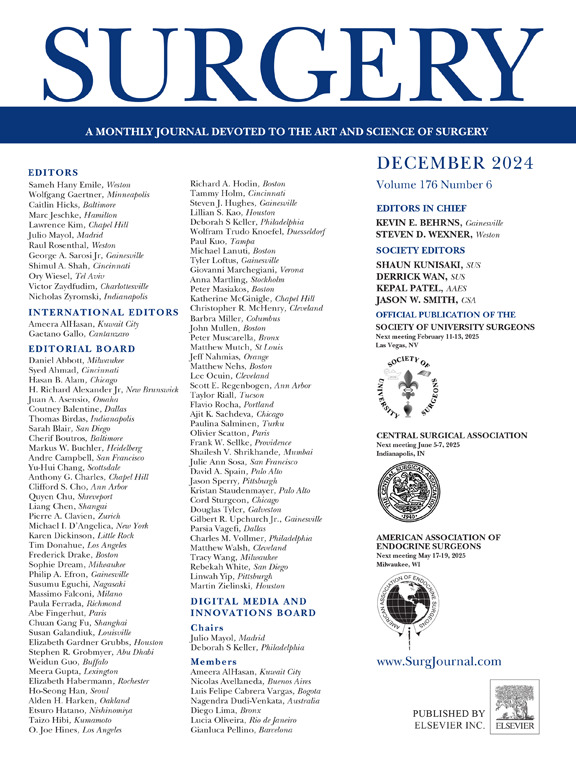Perioperative risks and risk factors in patients with cirrhosis undergoing abdominal wall hernia repair: A population-level analysis
IF 3.2
2区 医学
Q1 SURGERY
引用次数: 0
Abstract
Background
Abdominal wall hernias are common in patients with cirrhosis and associated with increased perioperative risk. Our objective was to describe the perioperative outcomes and risk factors in a contemporary population of patients with cirrhosis undergoing hernia repair.
Methods
A retrospective, population study on adult patients with cirrhosis undergoing abdominal wall hernia surgery in Ontario between 2009 and 2018. Outcomes included 90-day mortality, postoperative liver decompensation events, complications, and blood transfusions. Adjusted relative risks were estimated from Poisson regression models for mortality and postoperative liver decompensation events.
Results
We identified 6,040 adults with cirrhosis who underwent hernia repair (inguinal, n = 2,494; umbilical, n = 1,199; ventral/incisional, n = 1,893; incarcerated, n = 454). Median age was 61 years, 76% were male, and 79% underwent elective operation. Overall mortality was 4% (15.5% for emergency repair, 1.1% for elective). Factors associated with 90-day mortality were age, hepatitis C or alcohol-associated cirrhosis, Charlson Comorbidity Index, emergent operation, Model for End-Stage Liver Disease-Sodium, and noninguinal hernia. In those undergoing elective surgery, factors associated with mortality included age, Charlson Comorbidity Index, hepatitis C, ventral/incisional hernia, and Model for End-Stage Liver Disease-Sodium. Factors associated with increased risk of 90-day postoperative liver decompensation events included a history of previous liver decompensation and Model for End-Stage Liver Disease-Sodium score. Complications occurred in 12.5% (23.8% emergency, 9.5% elective); surgical-site infection (15.0% and 4.8%), venous thromboembolism (2.4% and 0.7%), and blood product transfusion (42.4% and 4.7%).
Conclusion
Emergency hernia repair in patients with cirrhosis is associated with increased complications, including an 8-fold increased risk of mortality, compared to elective surgery. These data support elective hernia repair in most patients with cirrhosis, taking into consideration age, other comorbidities, cirrhosis etiology and severity.
肝硬化腹壁疝修补术患者围手术期风险及危险因素:人群水平分析
背景腹壁疝在肝硬化患者中很常见,并与围手术期风险增加相关。我们的目的是描述当代肝硬化患者行疝修补术的围手术期结局和危险因素。方法对2009年至2018年安大略省接受腹壁疝手术的成年肝硬化患者进行回顾性人群研究。结果包括90天死亡率、术后肝失代偿事件、并发症和输血。校正后的相对危险度由死亡率和术后肝失代偿事件的泊松回归模型估计。结果:我们确定了6040例接受疝修补术的肝硬化成人(腹股沟,n = 2494;脐带,n = 1199;腹侧/切口,n = 1893;被监禁,n = 454)。中位年龄61岁,76%为男性,79%为择期手术。总死亡率为4%(急诊修复15.5%,择期修复1.1%)。与90天死亡率相关的因素有年龄、丙型肝炎或酒精相关性肝硬化、Charlson合并症指数、紧急手术、终末期肝病模型钠和非腹股沟疝。在接受择期手术的患者中,与死亡率相关的因素包括年龄、Charlson合并症指数、丙型肝炎、腹侧/切口疝和终末期肝病模型钠。与术后90天肝失代偿事件风险增加相关的因素包括既往肝失代偿史和终末期肝病模型-钠评分。并发症发生率12.5%(急诊23.8%,择期9.5%);手术部位感染(15.0%和4.8%)、静脉血栓栓塞(2.4%和0.7%)和血液制品输血(42.4%和4.7%)。结论:与择期手术相比,肝硬化患者急诊疝修补术与并发症增加相关,包括死亡风险增加8倍。考虑到年龄、其他合并症、肝硬化病因和严重程度,这些数据支持大多数肝硬化患者选择疝修补术。
本文章由计算机程序翻译,如有差异,请以英文原文为准。
求助全文
约1分钟内获得全文
求助全文
来源期刊

Surgery
医学-外科
CiteScore
5.40
自引率
5.30%
发文量
687
审稿时长
64 days
期刊介绍:
For 66 years, Surgery has published practical, authoritative information about procedures, clinical advances, and major trends shaping general surgery. Each issue features original scientific contributions and clinical reports. Peer-reviewed articles cover topics in oncology, trauma, gastrointestinal, vascular, and transplantation surgery. The journal also publishes papers from the meetings of its sponsoring societies, the Society of University Surgeons, the Central Surgical Association, and the American Association of Endocrine Surgeons.
 求助内容:
求助内容: 应助结果提醒方式:
应助结果提醒方式:


